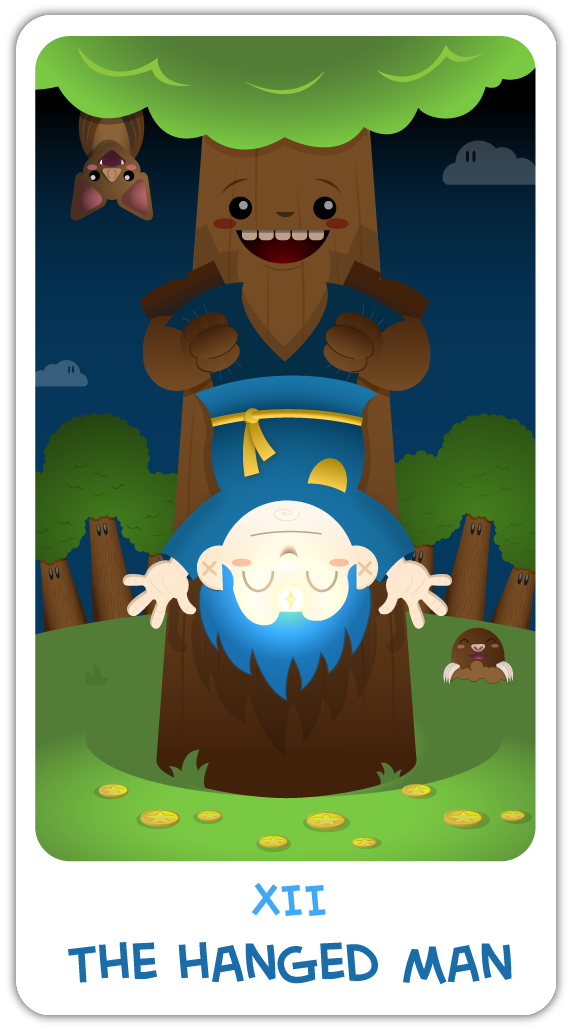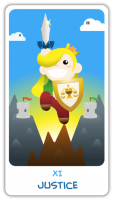
There is to my mind very little ambiguity around the Hanged Man. Without question it is a card of discomfort and disorientation; the man himself is inverted, head where his feet should be, near the earth (listening to its secrets, perhaps, the sounds of moles scratching in the earth and worms sliding through the grime), feet where the head should be, dangling useless, fruitless, unable to ambulate. The man is isolated, trapped by the situation he finds himself in. But his saintly face tells another story, one of enlightenment, an understanding of inversion, peace with his position.
Pamela Smith’s version has the man hanging legs crossed, arms behind his back, red tights, blue jerkin; the pseudo-medieval aspect of the deck maintained in the fanciful nature of his peasant dress. Her writer, Waite, pointed out the living nature of the Tau cross from which he hangs, a trellis rather than a crucifix.
Frieda Harris maintains the crossed legs, but pushes the figure beyond humanity into the world of faceless universality; a meta-martyr, an abstract asexual hanging from a steel ankh pegged to a white sun. Here the Smith-Waite trellis has been transformed into an unrelenting grid behind or beneath the main figure, whose symbolism, like so many of Crowley’s figures, is undoubtedly cryptically specific.
There’s a certain brutal truth to the Harris painting, the kind of truth that Crowley reveled in and taunted traditionals and fundamentalists with. A truth surely tucked away somewhere in Crowley’s twisting, rabbit hole of a guide The Book of Thoth, but one made plain by Joseph Campbell in his Hero With a Thousand Faces:
Campbell never mentions the tarot or its Hanged Man, but the fact is that it fits neatly into the descriptions of saviors that he lists above. With the Hanged Man we can take our pick of saviors, because ultimately it doesn’t matter really if this is Christ, pinned to the tree against his will, or if this is Buddha or Odin, pinning themselves to the tree of their own volition and battling all the demons of existence or their own physical pain in order to make themselves ready for enlightenment. What matters is that the hero is willing to peg themselves to the tree, to pin themselves to the world current, to tie themselves to the Earth’s massive mast, to hear the songs of existential sirens as their ship sails past the rocks of ruin; to resist the temptation to succumb to painless cessation, to endure the pain of their pinions and return to earth bruised and battered but enlightened, having conquered death, ignorance and darkness through the physical sacrifice of their mortal coils.
Given this dramatic heritage it’s lamentable that the Hanged Man is so often interpreted as a card of momentary inconvenience, where the querent is trapped in a situation they find uncomfortable, unwilling to see the light at the end of the tunnel. This may be true, but it is a little truth for such a large card. It is difficult for me to reconcile the minor inconvenience of a difficult situation at work, say, with the radical pain of enlightenment. The disparity though between the two points to the key element of the Hanged Man for me, which, in my own history (both with the tarot and the Work), has so often been omitted: that is the question of intention.
Each of the saviors that I have mentioned, all of whom are the Hanged Man’s spiritual kin, knew that the moment of their ascendance onto the tree was preordained and went forward and met it freely. For the Buddha there were signs that it was the time for him to take his place under the bo tree and battle for enlightenment. Odin sacrificed himself to himself in order gain insight into the runes and the 9 realms. Jesus wrestles with Yaweh and his fate in the garden of Gesthemene the night before his crucifixion. There is an intentionality inherent in what these heroes do that is missing from the neatness of simply finding the silver lining in an otherwise inconvenient situation. These saviors purposefully and intentionally sacrificed themselves for an enlightenment. They do not suddenly find themselves stuck to a tree; they put themselves there in order to accomplish a greater good. They intentionally exploit their mortality for a greater insight into the reality of existence.
In the case of the Chibi Tarot’s Hanged Man, this intentionality is symbolized by the coins beneath him on the earth; they were scattered before he ascended the tree. The coins themselves are proof of his intention to leave behind the things of this world and ascend the tree in order to gain metaphysical insight. It is this intention that is missing from so much of what I’ve felt is the traditional interpretation of this card. That intention is what the look on the hanged man’s face is all about. Without intention to transcend the physical discomfort of his situation the Hanged Man is merely a victim, at the mercy of the world around him, in no way responsible for the situation he finds himself in, able to blame the people around him for putting him in this place. Christ, Buddha and Odin have no one to blame for their lots but themselves. Can we do any less?
This level of meaning adds an important layer of of accountability for the querent who has put themselves into the position that they’re in. One of my favorite quotes I first heard from the teacher Orion Foxwood is that we will heal when we no longer find value in the pain. If we have, for whatever reason, pinned ourselves to a tree and do not see our own part in it, we will continue to hang, savoring, on one level or another, the role of the victim. If we cannot take responsibility for the situations we have gotten ourselves into then we will never be able to remove the spear from our side, untie ourselves from the tree and sit in the glow of our own enlightenment. If we continue to value the pain over the enlightenment then the pain is what we will continue to endure. If, however, we can, in some small way, acknowledge our own complicity in the position we’re in, we have taken one step closer to attaining the holy glow of the saint’s face as he hangs from his cross, the lesson that the Hanged Man is seeking to teach us.

